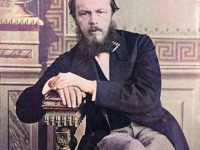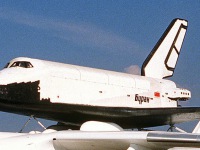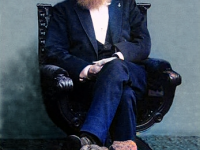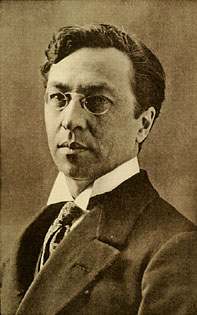
Wassily Kandinsky (1866-1944)
On December 16, 1866, Russian painter and art theorist Wassily Kandinsky was born. With Franz Marc he was co-founder of the editorial association Der Blaue Reiter. Kandinsky was an artist of Expressionism and one of the pioneers of abstract art. He is often named as the creator of the world’s first abstract painting according to his own statements, which may, however, have been predated by the year 1910 instead of 1913.
“The first colours which made a strong impression on me were light juice green, white, crimson red, black and yellow ocher. These memories go back to the third year of my life. I saw these colours on various objects [houses and roofs, in Russia] which are not as clear in my mind as the colours themselves.”
— Wassily Kandinsky, My Autobiography (1918)
Youth and Education
Wassily Kandinsky was born into a wealthy tea merchant family from Moscow, who soon moved to Odessa. His father, Wassily Kandinsky senior, came from Eastern Siberia, his mother was Lydia Ticheeva from Moscow. His parents separated in 1871, so that he was brought up mainly by his aunt Elizabeth Ticheeva. Until 1885 he travelled every year with his father to his hometown Moscow. He received drawing and painting lessons. After graduating from high school in 1885 at the humanistic grammar school in Odessa, he began studying law, economics and ethnology at Lomonosov University in Moscow in 1886. During his studies he painted and visited art exhibitions.
In 1889 Kandinsky undertook an expedition to the northern Ural Mountains to study the legal system of the Syrjans. He was fascinated by the mythical, abstract paintings on the drums of this primitive people. The influence of these impressions can be clearly seen in Kandinsky’s early work. In 1892, he completed his studies with a law degree and married his cousin Anna Tschimiakin. In the following year he became assistant to the law faculty at Moscow University, received his doctorate with a dissertation on the legality of workers’ wages and was appointed attaché to the law faculty.
In 1895 Kandinsky worked as the artistic director of a printing house in Moscow. In 1896 he rejected an appointment to the Estonian University in Dorpat, opted for painting and moved to Munich, where he first attended Anton Ažbe’s private painting school from 1897 to 1899 and met Alexej von Jawlensky for the first time. From 1900 he studied at the Munich Art Academy under Franz von Stuck.
Phalanx and Münchner Künstlervereinigung
In 1901, together with Wilhelm Hüsgen and other artists, he was one of the founders of the artist group Phalanx and head of the associated “School for Painting and Nude Drawing“. However, the response was so low that the exhibition and teaching activities had to be discontinued in 1904. In 1902 Kandinsky was exhibited for the first time in the Berlin Secession. Between 1903 and 1904 he travelled to Italy, the Netherlands and North Africa, and also visited Russia. Despite his stay abroad, Kandinsky had meanwhile become a full member of the Deutscher Künstlerbund and took part in its third annual exhibition in 1906 at the Großherzogliches Museum in Weimar.
For Kandinsky’s artistic development, Murnau am Staffelsee was a decisive station. There, in the summer of 1908, he and Münter had a significant collaboration with Marianne von Werefkin and Alexej Jawlensky. In a short time Kandinsky and Münter developed into expressionist painters through their far more progressive colleagues. On 1 January 1911, Kandinsky and Münter stayed in Marianne von Werefkin’s studio apartment in Munich; Franz Marc joined them there for the first time. Already in February, Marc became a member of the Münchner Künstlervereinigung (N.K.V.M), which Kandinsky had already joined in 1909.[8]
The Birth of Der Blaue Reiter
When more and more disagreements arose in the N.K.V.M., which were ignited by Kandinsky’s increasingly abstract painting, Kandinsky resigned from the chairmanship of the N.K.V.M. in 1911. He intended to publish an “Art Almanac“, which he initially wanted to call “The Chain“. He won Franz Marc to join in by offering him the joint editing of the book Der Blaue Reiter.
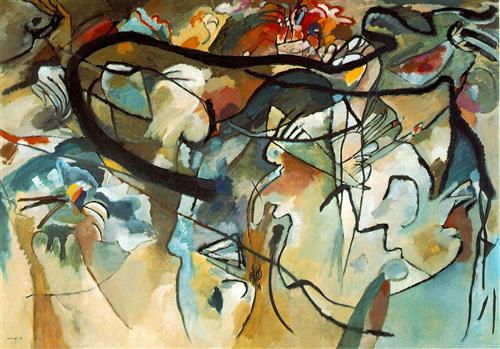
Das Jüngste Gericht/Komposition V, 1911
Kandinsky painted the legendary abstract painting with the meaningful title Das Jüngste Gericht/Komposition V (The Last Judgement/Composition V), which, at over five square meters, clearly violated the statutes of the N.K.V.M. On December 2, the picture was presented to the jury and consequently failed. “Pretending “protest” Kandinsky and Marc left the N.K.V.M. Münter and Alfred Kubin joined them. On December 18, 1911, the first exhibition of the editorial staff’s Der Blaue Reiter was opened at the Moderne Galerie Thannhauser in Munich. The exhibition was accompanied by Kandinsky’s book Über das Geistige in der Kunst, insbesondere in der Malerei (On the Spiritual in Art, especially in painting). The almanac “Der Blaue Reiter” appeared half a year later, in May 1912. The thoughts collected in these writings were of fundamental importance for the further development of abstract painting.
Back to Russia
After the German declaration of war against Russia on August 1, 1914, Kandinsky could not stay in Germany and fled with Gabriele Münter to Switzerland on August 3. From there he travelled without Münter via Zurich to Russia in November and settled in Moscow. On 11 February 1917 he married Nina Nikolajewna Andreevskaja in his second marriage after he had already divorced his first wife in 1911 and had broken up with Gabriele Münter after a last meeting in Stockholm in 1916. In January 1918 Kandinsky became a member of the Department of Visual Arts (IZO) at Narkompros. In 1920, however, he assumed his most important function as the first director of the Institute for Artistic Culture (INChUK) in Moscow, where he met the leading artists of the Russian avant-garde.
Wassily Kandinsky and Bauhaus
The conditions in the new Soviet Union – the restrictions on artistic freedom imposed by the new rulers – became increasingly unbearable for him. In December 1921, the couple travelled via Riga to Berlin, and in June 1922, following Walter Gropius‘ call,[1] Kandinsky began teaching at the workshop for mural painting at the Bauhaus in Weimar.[1] Until the closing of the Bauhaus by the National Socialists in 1933, Kandinsky worked as a teacher in Weimar, Dessau and Berlin, where he came into contact with Russian Constructivism. During this time, geometric structures finally prevailed in his paintings. In Dessau, together with Paul Klee, he was one of the residents of the Bauhaus Master Houses.[7]
In 1924 he founded the artist group Die Blaue Vier with Lyonel Feininger,[2] Paul Klee and Alexej von Jawlensky. In 1926 he published his theoretical writing: Punkt und Linie zu Fläche (Point and Line to Surface). In 1928 he acquired German citizenship. In 1929 his first solo exhibition of watercolors and drawings took place at the Galerie Zack in Paris.
In 1930 he met Solomon R. Guggenheim in Dessau, an encounter, which had persuaded Guggenheim to create a collection of abstract contemporary art. Guggenheim bought several paintings, which gradually became one of the largest collections of Kandinsky works, with over 150 works on display at the Museum of Non-Objective Painting, now the Guggenheim Museum.
Emigration to France
After the closing of the Bauhaus by the National Socialists in 1933, the Kandinsky couple emigrated to France and moved to Neuilly-sur-Seine near Paris. Kandinsky found it difficult to gain a foothold here, as abstract art received little recognition and Cubist and Surrealist works predominated in the galleries. In 1934 he participated in the exhibition of the Abstraction-Création movement in Paris. In 1936 he took part in the exhibitions Abstract and Concrete in London and Cubism and Abstract Art in New York. In 1939 the couple became French citizens.
In 1937, 57 of his works were confiscated in German museums by the National Socialists and 14 of them were shown in the exhibition Degenerate Art in Munich.[3] In the same year he took part in the Paris exhibition Origines et Dévellopment de l’Art International Indépendant at the Musée Jeu de Paume. In 1944, his last exhibition, which he witnessed, took place at the Galerie l’Esquisse in Paris. Wassily Kandinsky, who painted daily until the end of July 1944, died on 13 December in Neuilly-sur-Seine.
“The geometric point is an invisible thing. Therefore, it must be defined as an incorporeal thing. Considered in terms of substance, it equals zero.. .Thus we look upon the geometric point as the ultimate and most singular union of silence and speech. The geometric point has, therefore, been given its material form, in the first instance, in writing. It belongs to language and signifies silence.”
— Wassiky Kandinsky, Point and line to plane (1926)
Posthumous Fame
Some of his works were shown posthumously at documenta 1 (1955), documenta II (1959), documenta III (1964) and documenta 8 in 1987 in Kassel. Kandinsky was a synesthete, so he perceived colours not only as optical, but also, for example, as acoustic stimuli. He assigned sounds, smells, shapes etc. to the colours. Thus he perceived yellow as a “pointed” colour, which increases in connection with the pointed shape of the triangle. Therefore he tried to paint pictures of how to compose music; he spoke of “color sounds” and compared the harmony of colors with the harmony of sounds. Kandinsky also saw the dangers for abstract art and wrote that the beauty of colour and form was not a sufficient goal of art.
HOW ARTISTS SEE – Kandinsky (Lecture 4 of 5) Prof Ian Aaronson, [9]
References and Further Reading:
- [1] Walter Gropius and the Bauhaus, SciHi Blog
- [2] The World of Lyonel Feininger, SciHi Blog
- [3] The Art Hitler Hated – the Degenerate Art Exhibition of 1937, SciHi Blog
- [4] Works by or about Wassily Kandinsky at Internet Archive
- [5] Wassily Kandinsky at the Museum of Modern Art
- [6] Wassily Kandinsky at Wikidata
- [7] Paul Klee – One of the most Important Artists of Classical Modern Art, SciHi Blog
- [8] Franz Marc – German Expressionism and Der blaue Reiter, SciHi Blog
- [9] HOW ARTISTS SEE – Kandinsky (Lecture 4 of 5) Prof Ian Aaronson, UCT Summer School @ youtube
- [10] Ulrike Becks-Malorny. Wassily Kandinsky 1866–1944: The Journey to Abstraction (Taschen, 2007).
- [11] John E. Bowlt and Rose-Carol Washton Long, eds. The Life of Vasilii Kandinsky in Russian Art: A Study of “On the Spiritual in Art” by Wassily Kandinsky. (Newtonville, MA.: Oriental Research Partners, 1984).
- [12] Hajo Düchting. Wassily Kandinsky 1866–1944: A Revolution in Painting. (Taschen, 2000)
- [13] Timeline for Wassily Kandinsky via Wikidata

